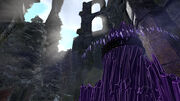
A mysterious object in Avendyr's Pass has a deadly Fracture.
Fractures are a Gameplay Mechanic. Fractures are similar in some ways to Climates, but while Climates are natural phenomena taken to the extreme, a Fracture is unnatural and metaphysical. Another difference is that Fractures tend to emanate out from a very specific area or object,[1] while Climates tend to be large scale and can't simply be walked around. There are both static fractures (meaning they will always be in that location) and spontaneous fractures which might pop up in other areas of the world. [2]
Mechanics[ | ]
The Fracture System presents the player with environmental dangers and obstacles or "questions" that require specific "answers" the player must acquire for themselves.
Here is a short list of possible Fractures you could encounter as you explore Terminus:
- Silencing Mists
- Fog of Confusion
- Gloom
- Frenetic Floor
- Curse of Intangibility
- Heavy Air
- Shifting Walls
Let's take a closer look at a Fracture from this list:
Gloom
The Gloom Fracture can be found permeating most Undead ruins, crypts and graveyards - places with a high concentration of Undead. This particular Fracture impacts players negatively and Undead non-player characters (NPCs) positively while in its area of effect.
|
Negative Effects on Players
|
Positive Effects on Undead
|
So how will players "answer" these strange and often dangerous environmental "questions"? By seeking and acquiring Artifacts.
Artifacts[ | ]
Artifacts are legendary rare items players can discover that offer unique utility. They are necessary to explore and overcome areas of the game where Fractures exist.
In the Gloom example above, players would need to acquire and equip the Bone-Woven Veil to mitigate Gloom’s negative effects.
Here is another short list of possible Artifacts you may discover and the special utility they provide:
- Shield of Mirrors: Forged by the master smiths of Khadassa, it can reflect light and has a chance to reflect magical attacks when blocking.
- Skyhold Grappler: Fashioned by the Gnomes of Skyhold to assist in advanced terrain traversement, the Skyhold Grappler can latch onto special surfaces and pull you to the target location.
- Ring of Anchors: Infused with the bitterness of the Dark Myr, this ring was designed to sink the wearer to the deepest reaches of the oceans.
- Crest of Illumination: This Archai crown was imbued with a powerful, resonating light source that can shine through the blackest darkness.
The Inspiration[ | ]
| “ | If you watch our live streams, you may hear me gush from time to time about early adventure games on consoles like the Super Nintendo — particularly games like A Link to the Past, Super Metroid, etc. As simple as those classic era games were, they still offer much to modern game design.
With Pantheon, we’ve said from the beginning that we want the environment to matter. One of the ways we are accomplishing this is with our Climate and Acclimation System (which I’ll cover in an upcoming Behind the Design). But while Climate deals with the extremes of natural phenomena players will encounter in Terminus, [Fractures] will present players with unnatural, metaphysical phenomena — the kind of phenomena that might occur when fantastical worlds collide. |
„ |
| ~ Chris "Joppa" Perkins |
Trivia[ | ]
- Fractures were formerly known as Atmospheres. The name of the mechanic was changed to avoid confusion with Climates. [3]
